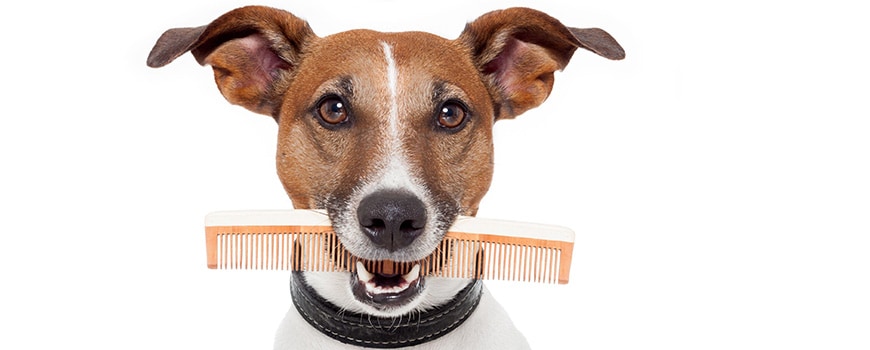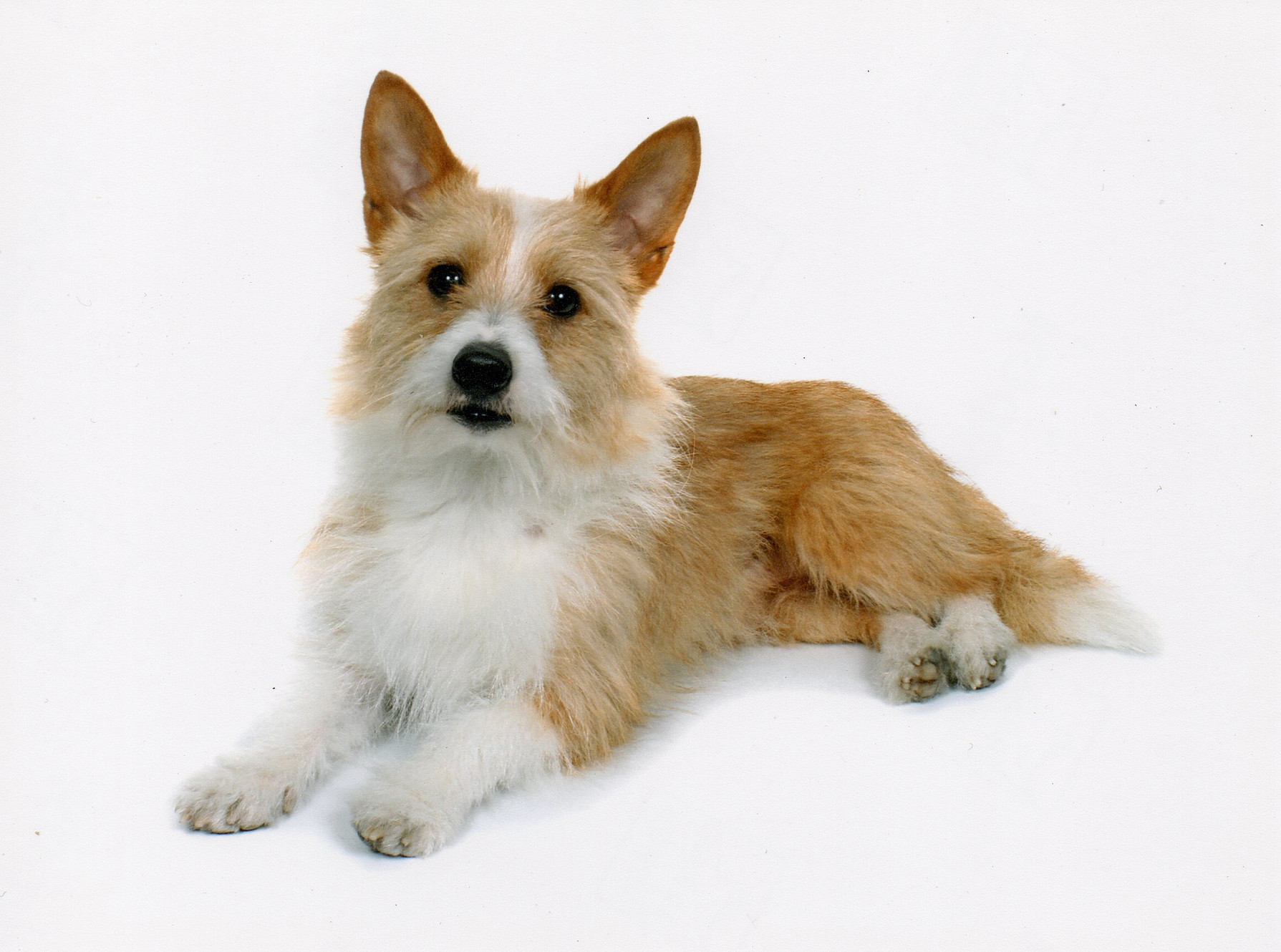Grooming a Portuguese Podengo does not require much effort if you decide to do it yourself. This is a very uncomplicated coat type in terms of grooming. The coat should look very natural, rustic and non-sculpted.
Grooming Summary:
- Top of skull is shorter and cheek areas are shorter.
- Finger pluck longer hair from stop area and around the lower eye area to accentuate a lively expression.
- Podengo has slightly longer, harsh hair over the eyes, forming small brows. The muzzle is covered with longer hair forming a hint of a beard.
- Ears are free of long hair.
- Brush, card, and rake to remove dead coat. As new hair grows in, it will be harsh and tighter fitting to the body.
- Neaten undercarriage line lightly.
- Trim nails as short as possible or grind.
- Neaten tail by finger plucking.
- Lightly clip sanitary areas.
- Shave pads and neaten feet to match legs.
- Neaten hocks.
Bathing and Drying a Podengo
Bathe your Podengo once a week to once every 12 weeks. Trim every four to six weeks to maintain a stylized fashion. Card and hand-strip dog prior to bathing and drying.
Use a regular, all-purpose shampoo. If the skin is exceptionally dry, apply a light skin conditioner, otherwise, bypass this step because the conditioner will soften the coat. That is undesirable for this coat type.
To be thorough, sink your fingers deeply into the coat while scrubbing. A rubber curry with cone-type teeth also does an excellent job of working the shampoo right to the skin and lifting dirt and debris to the surface where it can easily be rinsed away.
A natural bristle scrub brush works very well on the shorter coat, especially around the feet and legs. With either a rubber curry or a scrub brush, scrub in the direction of the coat growth.
A number of drying methods can be used on this coat type. Start with a vigorous hand towel drying. Follow with high-velocity drying in the direction of the coat growth to remove excess moisture and to blow out the bulk of the loose fur, using the most powerful setting the dog will tolerate.
When no moisture is being sprayed from the fur and/or no loose coat is being blown out, another drying method may be used. Many stylists remove the condenser cone and continue with the high-velocity dryer, holding the end of the nozzle close to the skin.
On pets that have been clipper-cut, areas that were trimmed with blades shorter than a #7F need no special drying attention.
Work the air in a small circular fashion, with the natural lay of the coat, until the coat is dry in that area. Drying may be continued with natural air-drying or kennel drying using a low temperature setting. Or, finish drying with a heat-stand dryer while brushing the coat.
Blanket drying also works well with this coat type if the coat is being hand-stripped. Once the bulk of the moisture is removed, use a fine brush or comb to brush the coat in the direction you want the hair to lie.
Drape a large towel over the body of the dog. Pin the towel snugly around the neck area and under the belly to flatten the coat. This drying technique will ensure the coat conforms to the natural outline of the dog.
Whatever process or combination of processes is used, drying is not finished until the coat is completely cool and dry to the touch.
Pre-Work
Trim or grind nails at least every four to six weeks to maintain a healthy foot structure. Swab the ears clean with a mild ear cleaning solution. Prior to bathing, quickly go over the entire body with a high-velocity dryer to help lift dirt and dander away from the skin and to loosen any shedding coat.
Brushing the Coat
Use a rubber curry, shedding blade, undercoat rake, pumice stone, carding tool, fine stripping knife, slicker brush or natural bristled brush to remove any remaining loose coat or tangles. Be careful when using any tool with metal teeth or bristles. A heavy hand or too much repetition in an area can cause cuts and/or brush burns.
Brushing is not finished until all loose fur is removed, or when it becomes difficult to remove more than a half a brush full after repeated brushing.
Carding the Coat
Carding is a natural technique in which the soft, downy undercoat is pulled from the dog’s body. Typical tools used with this technique are: a pumice stone; a fine-toothed stripping knife that is pulled through the coat; an undercoat rake; or a fine blade, such as a #40, held between the fingers and pulled through the coat.
Carding can be done before or after bathing and drying. Removal of the soft undercoat allows the topcoat to lie closer to the natural outline of the dog and accentuate the dog’s structure. It also, promotes profuse harsh outer coat, creates a rich coat color and protects the skin.
Hand-Stripping
Hand-stripping is a technique in which the outer guard coat is plucked from the dog’s skin. This procedure helps retain the proper coat texture and rich color of the breed. During certain times of the year the coat is easier to pull out.
When the coat easily comes out, it is called a “blowing coat” or “blown coat.” Ideally, hand-stripping should correspond with the dog’s natural cycle, based on the environment and its hormonal levels.
Using your fingers, a carding tool or a stripping knife, pull out a few hairs at a time to shape the coat, accentuating the natural outline of the dog. Work methodically, pulling small amounts of coat at a time, always working in the direction of the coat growth.
Proper hand-stripping removes hair with a gentle momentum and rhythm, not brute force, which is uncomfortable for both groomer and dog. The wrist stays locked in a neutral position while the rhythmic movement stems from the shoulder, not the wrist or elbow.
In general, the main body coat is easy to remove. Most dogs do not mind the plucking process. The cheeks, throat and private areas may be more sensitive, requiring thinning shears or clippers. Leave enough coat to be between I to 2 inches long.
The coat should always appear very natural, never clipped or heavily trimmed. On some coats, a light application of chalk or powder before the bath will allow a better grip and make plucking and stripping much easier.
Head
Leave the coat longer on the muzzle. Hand-strip or pluck the top skull, throat and cheeks. Leave triangles of coat above each eye to form the moderate bushy eyebrows that accentuate the eye area.
Remove any longer hair from the ears that distract from their natural outline.
Feet & Hocks
Trim the pads with a close cutting blade ranging from a #15 to a #40. Use a very light touch to clean the pads of long hair. Tidy the outside edge of the foot, if needed, with small detailing shears. If the hocks have longer coat, trim lightly with thinning shears to show a neat, clean area.
Detail Finish
For added shine, finish with a fine mist of coat polish on the body. Application of bows and mild cologne is optional.
Note
Clipping a wired-coated dog will result in a dramatic change in the texture and color of the coat. The correct harsh wire coat needs to be encouraged by plucking the blown coat when it is ready to be removed. This process stimulates hair follicles to produce new guard coat.
Without hand-stripping, the guard coat is not stimulated and will not grow in properly. It will lose its brilliant color and texture. If only the undercoat grows, the guard coat color becomes that of the lighter, soft undercoat.
Suggested Tools & Equipment
- Nail Trimmers
- Styptic Powder
- Ear Powder
- Ear Cleaning Solution
- Cotton Balls
- Hemostat
- Clippers
- Slicker Brush
- Greyhound Comb
- Pumice Stone
- Carding Tools
- Stripping Knives
- Straight Shears
- Curved Shears
- Small Detailing Shears
- Thinning Shears
- Dematting Tools


